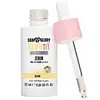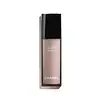What's inside
What's inside
 Key Ingredients
Key Ingredients

 Benefits
Benefits

 Concerns
Concerns

 Ingredients Side-by-side
Ingredients Side-by-side

Water
Skin Conditioning3-O-Ethyl Ascorbic Acid
Skin ConditioningPropylene Glycol
HumectantSodium Citrate
BufferingPolysorbate 20
EmulsifyingPolyacrylate Crosspolymer-6
Emulsion StabilisingEthylhexylglycerin
Skin ConditioningSodium Hyaluronate
HumectantBenzyl Alcohol
PerfumingCitric Acid
BufferingXanthan Gum
EmulsifyingAlcohol
AntimicrobialTetrasodium EDTA
Limonene
PerfumingDipropylene Glycol
HumectantTris(Tetramethylhydroxypiperidinol)Citrate
StabilisingParfum
MaskingLinalool
PerfumingAlcohol Denat.
AntimicrobialSodium Hydroxide
BufferingCI 14700
Cosmetic ColorantCI 15985
Cosmetic ColorantCI 19140
Cosmetic ColorantWater, 3-O-Ethyl Ascorbic Acid, Propylene Glycol, Sodium Citrate, Polysorbate 20, Polyacrylate Crosspolymer-6, Ethylhexylglycerin, Sodium Hyaluronate, Benzyl Alcohol, Citric Acid, Xanthan Gum, Alcohol, Tetrasodium EDTA, Limonene, Dipropylene Glycol, Tris(Tetramethylhydroxypiperidinol)Citrate, Parfum, Linalool, Alcohol Denat., Sodium Hydroxide, CI 14700, CI 15985, CI 19140
Water
Skin ConditioningAlcohol
AntimicrobialGlycerin
HumectantC8-12 Acid Triglyceride
Skin ConditioningPentylene Glycol
Skin ConditioningHydroxypropyl Starch Phosphate
Ipomoea Batatas Root Extract
Skin ConditioningFaex
Skin ConditioningMedicago Sativa Extract
TonicMentha Piperita Stem Extract
AntioxidantDipropylene Glycol
HumectantSodium Polyacrylate
AbsorbentCaprylyl Glycol
EmollientTapioca Starch
Parfum
MaskingXanthan Gum
EmulsifyingArginine
MaskingPropylene Glycol
HumectantLecithin
EmollientSclerotium Gum
Emulsion StabilisingPhenoxyethanol
PreservativePullulan
Sodium Hyaluronate
HumectantAdenosine
Skin ConditioningPropanediol
SolventPolyquaternium-51
Skin ConditioningLactic Acid
BufferingEthylhexylglycerin
Skin ConditioningPhytic Acid
Silica
AbrasiveSodium Hydroxide
BufferingHydrochloric Acid
BufferingSodium Citrate
BufferingPalmitoyl Tetrapeptide-7
Skin ConditioningSodium Benzoate
MaskingCI 14700
Cosmetic ColorantWater, Alcohol, Glycerin, C8-12 Acid Triglyceride, Pentylene Glycol, Hydroxypropyl Starch Phosphate, Ipomoea Batatas Root Extract, Faex, Medicago Sativa Extract, Mentha Piperita Stem Extract, Dipropylene Glycol, Sodium Polyacrylate, Caprylyl Glycol, Tapioca Starch, Parfum, Xanthan Gum, Arginine, Propylene Glycol, Lecithin, Sclerotium Gum, Phenoxyethanol, Pullulan, Sodium Hyaluronate, Adenosine, Propanediol, Polyquaternium-51, Lactic Acid, Ethylhexylglycerin, Phytic Acid, Silica, Sodium Hydroxide, Hydrochloric Acid, Sodium Citrate, Palmitoyl Tetrapeptide-7, Sodium Benzoate, CI 14700
Ingredients Explained
These ingredients are found in both products.
Ingredients higher up in an ingredient list are typically present in a larger amount.
Alcohol comes in many different forms. Different types of alcohol will have different effects on skin. This ingredient is usually an astringent alcohol.
These alcohols are drying on the skin. They may strip away your skin's natural oils and even damage your skin barrier. Astringent alcohols may also irritate skin.
Other types of astringent alcohols include:
According to the National Rosacea Society based in the US, you should be mindful of products with these alcohols in the top half of ingredients.
Any type of sanitizing product will have high amounts of alcohol to help kill bacteria and viruses.
Fatty alcohols come from plant oils such as coconut oil. These can help hydrate the skin and are non-irritating. Some fatty alcohols include cetyl and stearyl alcohol.
Learn more about AlcoholCi 14700, also known as Red No. 4, is a synthetic red dye derived from petroleum. It is water soluble.
Dipropylene Glycol is a synthetically created humectant, stabilizer, and solvent.
This ingredient helps:
Dipropylene glycol is technically an alcohol, but it belongs to the glycol family (often considered part of the ‘good’ alcohols). This means it is hydrating and gentle on skin unlike drying solvent alcohols like denatured alcohol.
As a masking agent, Dipropylene Glycol can be used to cover the smell of other ingredients. However, it does not have a scent.
Studies show Dipropylene Glycol is considered safe to use in skincare.
Learn more about Dipropylene GlycolEthylhexylglycerin (we can't pronounce this either) is commonly used as a preservative and skin softener. It is derived from glyceryl.
You might see Ethylhexylglycerin often paired with other preservatives such as phenoxyethanol. Ethylhexylglycerin has been found to increase the effectiveness of these other preservatives.
Parfum is a catch-all term for an ingredient or more that is used to give a scent to products.
Also called "fragrance", this ingredient can be a blend of hundreds of chemicals or plant oils. This means every product with "fragrance" or "parfum" in the ingredients list is a different mixture.
For instance, Habanolide is a proprietary trade name for a specific aroma chemical. When used as a fragrance ingredient in cosmetics, most aroma chemicals fall under the broad labeling category of “FRAGRANCE” or “PARFUM” according to EU and US regulations.
The term 'parfum' or 'fragrance' is not regulated in many countries. In many cases, it is up to the brand to define this term.
For instance, many brands choose to label themselves as "fragrance-free" because they are not using synthetic fragrances. However, their products may still contain ingredients such as essential oils that are considered a fragrance by INCI standards.
One example is Calendula flower extract. Calendula is an essential oil that still imparts a scent or 'fragrance'.
Depending on the blend, the ingredients in the mixture can cause allergies and sensitivities on the skin. Some ingredients that are known EU allergens include linalool and citronellol.
Parfum can also be used to mask or cover an unpleasant scent.
The bottom line is: not all fragrances/parfum/ingredients are created equally. If you are worried about fragrances, we recommend taking a closer look at an ingredient. And of course, we always recommend speaking with a professional.
Learn more about ParfumPropylene Glycol is an odorless, colorless liquid. As a humectant, it helps skin retain moisture. It also aids in delivering active ingredients.
Another role of this ingredient is preventing a product from melting or freezing. Propylene glycol also adds antimicrobrial properties to a product, elongating product lifespan.
This ingredient is considered an organic alcohol and commonly added into both cosmetics and foods.
Those with sensitive skin or conditions may develop a rash when using this ingredient.
Learn more about Propylene GlycolSodium Citrate is the sodium salts of citric acid. In skincare, it is used to alter pH levels and acts as a preservative.
Its main functions are to maintain the pH of a product and neutralize metal ions.
The acidity of our skin is maintained by our glands and skin biome; normal pH level of skin is slightly acidic (~4.75-5.5).
Being slightly acidic allows our skin to create an "acid mantle". This acid mantle is a thin barrier that protects our skin from bacteria and contaminants.
Learn more about Sodium CitrateSodium Hyaluronate is hyaluronic acid's salt form. It is commonly derived from the sodium salt of hyaluronic acid.
Like hyaluronic acid, it is great at holding water and acts as a humectant. This makes it a great skin hydrating ingredient.
Sodium Hyaluronate is naturally occurring in our bodies and is mostly found in eye fluid and joints.
These are some other common types of Hyaluronic Acid:
Learn more about Sodium HyaluronateSodium Hydroxide is also known as lye or caustic soda. It is used to adjust the pH of products; many ingredients require a specific pH to be effective.
In small amounts, sodium hydroxide is considered safe to use. However, large amounts may cause chemical burns due to its high alkaline.
Your skin has a natural pH and acid mantle. This acid mantle helps prevent harmful bacteria from breaking through. The acid mantle also helps keep your skin hydrated.
"Alkaline" refers to a high pH level. A low pH level would be considered acidic.
Learn more about Sodium HydroxideWater. It's the most common cosmetic ingredient of all. You'll usually see it at the top of ingredient lists, meaning that it makes up the largest part of the product.
So why is it so popular? Water most often acts as a solvent - this means that it helps dissolve other ingredients into the formulation.
You'll also recognize water as that liquid we all need to stay alive. If you see this, drink a glass of water. Stay hydrated!
Learn more about WaterXanthan gum is used as a stabilizer and thickener within cosmetic products. It helps give products a sticky, thick feeling - preventing them from being too runny.
On the technical side of things, xanthan gum is a polysaccharide - a combination consisting of multiple sugar molecules bonded together.
Xanthan gum is a pretty common and great ingredient. It is a natural, non-toxic, non-irritating ingredient that is also commonly used in food products.
Learn more about Xanthan Gum